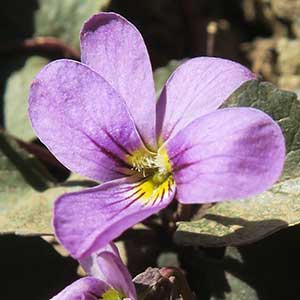Viola cuneata
Viola flettii
northern two-eyed or wedge-leaf violet, northern two-eyed violet, wedge-leaf violet
Flett's violet, Olympic violet, rock violet
1–3, usually erect, sometimes prostrate or ascending, glabrous, from shallow, fleshy rhizome or deep-seated caudex with fleshy roots.
1–3, ascending to erect, mostly glabrous, on caudex from fleshy rhizome.
basal and cauline;
basal: 2–6;
stipules lanceolate, margins entire or gland-toothed, apex acute;
petiole 4.5–9.8 cm, glabrous;
blade purple-veined, orbiculate-ovate to deltate, 1–4 × 2.7–3.8 cm, usually shiny, leathery, base cuneate, margins serrate, eciliate, apex acute, mucronulate, surfaces glabrous;
cauline similar to basal except: stipules lanceolate to ovate, margins entire or erose to lacerate, with or without gland-tipped processes, apex acute to acuminate;
petiole 0.5–20 cm;
blade usually rhombic, sometimes orbiculate, 0.9–2.6 × 0.7–1.8 cm, margins crenate to ± serrate, apex acute to obtuse.
basal and cauline;
basal: 1–3;
stipules linear-lanceolate, margins entire or with glandular processes, apex acuminate;
petiole 1.5–9.7 cm, mostly glabrous;
blade purple-tinted and –veined, broadly reniform to ovate, 0.9–2.4 × 1.2–4 cm, base cordate, margins finely crenate-serrate, eciliate, apex acute to obtuse, surfaces glabrous or sparsely pubescent along veins adaxially;
cauline similar to basal except: stipules ovate to lanceolate, margins entire or shallowly laciniate;
petiole 0.7–5.9 cm, usually glabrous;
blade 0.8–2.1 × 1.2–3.1 cm.
1–10.5 cm, glabrous.
1.8–7.1 cm, usually glabrous.
sepals lanceolate, margins eciliate, auricles 0.5–1 mm;
petals deep reddish violet abaxially, white adaxially, upper 2 sometimes with purple patch basally, lateral 2 with purple patch basally beyond smaller yellow area, usually bearded, sometimes beardless, lowest purple-veined with yellow area basally, 8–14 mm, spur yellow, gibbous, 1–2 mm;
style head bearded; cleistogamous flowers axillary.
sepals lanceolate, margins eciliate, auricles 0.5–1.5 mm;
petals soft reddish violet on both surfaces, all with yellow area basally, lower 3 dark violet-veined, lateral 2 bearded, lowest with white around yellow area, 10–15 mm, spur yellow, gibbous, 0.5–2 mm;
style head bearded; cleistogamous flowers axillary.
± spherical, 5–9 mm, glabrous.
± spherical, 5–9 mm, glabrous.
deep brown-purple, 2.1–3 mm.
dark brown to brownish purple, 2.5–3 mm.
Viola cuneata
Viola flettii
Viola cuneata often occurs on serpentine-derived soil and is closely related to V. flettii, V. hallii, and V. ocellata (V. B. Baird 1942). Originally described as beardless by Watson, the lateral petals of flowers in the same population can be prominently bearded or essentially beardless. The cauline blades of Viola cuneata are often vertical, especially early in season.
(Discussion copyrighted by Flora of North America; reprinted with permission.)
Viola flettii is endemic to the Olympic Mountains of northwestern Washington. C. S. McCreary (2005) noted that although morphologically and ecologically distinct, V. cuneata, V. flettii, and V. ocellata are closely related.
(Discussion copyrighted by Flora of North America; reprinted with permission.)


